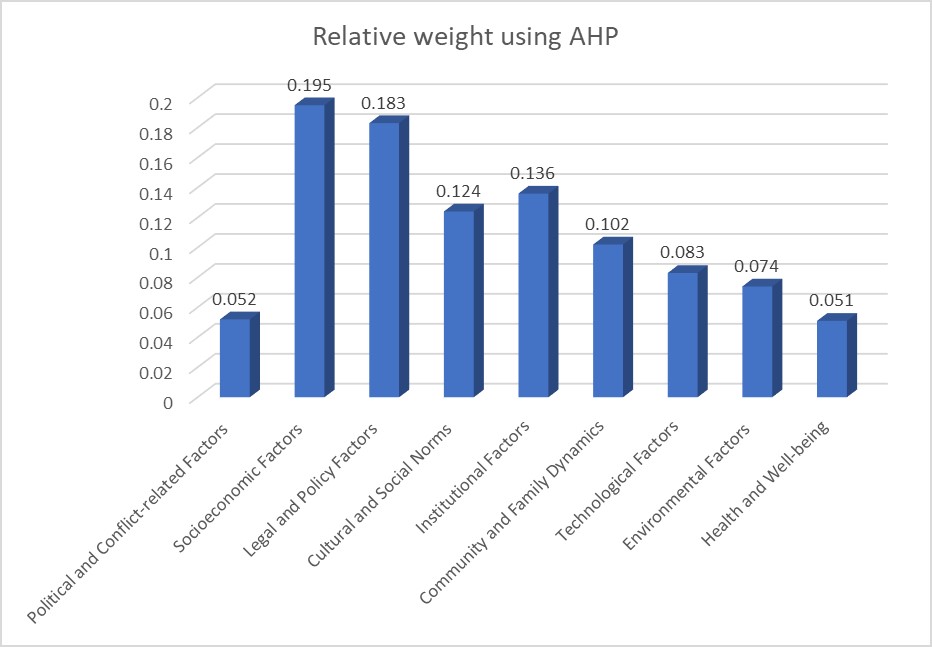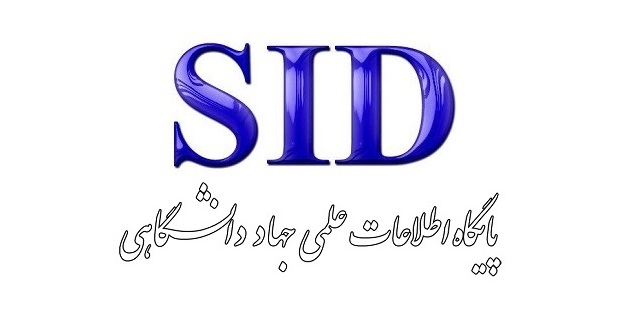Factors Influencing Women's Security in Society: Integrating Thematic Analysis and the Analytic Hierarchy Process with Emphasis on Social Well-being
Keywords:
Women's security, Thematic analysis, Analytic Hierarchy Process (AHP)Abstract
Background and Objective: This study investigates the factors influencing women's security in society using a framework of Thematic Analysis and the Analytic Hierarchy Process (AHP). By identifying and prioritizing these factors, the research contributes to the development of effective strategies to enhance the safety and well-being of women. This study adopted a mixed-method approach, combining Thematic Analysis with the Analytic Hierarchy Process. Thematic Analysis was utilized to identify key themes and patterns in the existing literature and empirical data related to women's security. Subsequently, the AHP methodology was employed to prioritize these factors based on expert judgments and pairwise comparisons. Thematic Analysis identified key dimensions of women's security, with socio-economic factors (relative importance = 0.195) ranking highest, followed by legal and political factors (relative importance = 0.183). Other significant factors included institutional factors (relative importance = 0.136), cultural and social norms (relative importance = 0.124), community and family dynamics (relative importance = 0.102), technology (relative importance = 0.083), environmental factors (relative importance = 0.074), political and conflict-related factors (relative importance = 0.052), and health and well-being factors (relative importance = 0.051). This study highlights the multifaceted nature of women's security and emphasizes the importance of addressing various factors comprehensively. By integrating Thematic Analysis with the AHP framework, the study provides valuable insights into understanding and addressing the complex challenges faced by women in society.
References
C. M. Chinkin and L. Gormley, "Violence against women," 2023, doi: 10.1093/law/9780192862815.003.0019.
G. Korir and H. Amunga, "Women's Participation in Governance and Political Processes in Kenya: Threats and Proposed Remedies," IARS' International Research Journal, vol. 11, no. 2, pp. 46-54, 2021, doi: 10.51611/iars.irj.v11i2.2021.173.
V. Lavanya and S. Mahima, "Empowerment of rural women through MGNREGA with special references to Palakkad," ZENITH International Journal of Multidisciplinary Research, vol. 3, no. 7, pp. 271-276, 2013. [Online]. Available: https://journal.iistr.org/index.php/JMSD/article/view/131.
S. C. M. Dantas et al., "Proposal to Combat Violence against Women from Women's Social and Financial Emancipation," International Journal of Advanced Engineering Research and Science, vol. 9, no. 5, 2022, doi: 10.22161/ijaers.95.14.
K. L. Norsworthy, Feminist Interventions for Southeast Asian Women Trauma Survivors: Deconstructing Gender-Based Violence and Developing Structures of Peace. 2002.
M. Lanham et al., ""We're Going to Leave You for Last, Because of How You Are": Transgender Women's Experiences of Gender-Based Violence in Healthcare, Education, and Police Encounters in Latin America and the Caribbean," Violence and Gender, vol. 6, no. 1, pp. 37-46, 2018, doi: 10.1089/vio.2018.0015.
E. M. King and M. A. Hill, Women's education in developing countries: Barriers, benefits, and policies. World Bank Publications, 1997.
R. de Souza, ""Motherwork" and communicative labor: A gendered analysis of hunger in marginalized US women," Frontiers in Communication, vol. 8, 2023, doi: 10.3389/fcomm.2023.1057472.
B. Owen, J. Wells, and J. Pollock, In search of safety: Confronting inequality in women's imprisonment. University of California Press, 2017.
C. Bain, E. Ransom, and I. Halimatusa'diyah, "Dairy Livestock Interventions for Food Security in Uganda: What are the Implications for Women's Empowerment?," Rural Sociology, vol. 85, no. 4, pp. 991-1020, 2020, doi: 10.1111/ruso.12332.
T. Bryant and D. Raphael, "Intersectionality Analysis, the Welfare State and Women's Health," Critical Studies: An International and Interdisciplinary Journal, vol. 13, no. 2, pp. 3-17, 2018, doi: 10.51357/cs.v13i2.126.
N. M. Ishengoma, "We get affected too: Women's occupational safety and health hazards in the fish processing subsector in Tanzania demystified," Heliyon, 2024, doi: 10.1016/j.heliyon.2024.e26259.
B. Hamber et al., "Discourses in transition: Re-imagining women's security," International Relations, vol. 20, no. 4, pp. 487-502, 2006, doi: 10.1177/0047117806069410.
K. Forsdike, J. Ison, L. Hooker, N. Henry, and A. Taft, ""God, whatever you do, don't tell people it's unsafe": Public transport service providers' perspectives on women's safety from sexual violence on public transport," Transport Policy, vol. 150, pp. 14-23, 2024, doi: 10.1016/j.tranpol.2024.03.005.
D. S. Madjdian et al., "Impact of a mass-media consumer awareness campaign on food safety behavior and behavioral determinants among women in Dire Dawa and Harar, Ethiopia," Food Control, 2024, doi: 10.1016/j.foodcont.2024.110509.
R. Kamatchi and N. Zade, "AI-Based Security Framework for Emotional and Personal Safety of Women," in Impact of AI on Advancing Women's Safety: IGI Global, 2024, pp. 14-23.
V. R. Bora and B. Nagpure, "V-Safe-Anywhere: Empowering Women's Safety With Wearable AI and IoT Technology," in Wearable Devices, Surveillance Systems, and AI for Women's Wellbeing: IGI Global, 2024, pp. 253-263.
G. Carpentieri, C. Guida, A. Gorrini, F. Messa, L. Abdelfattah, and B. Büttner, "Digital data to support urban planning processes to develop women safety cities: an application to the city of Naples," TeMA - Journal of Land Use, Mobility and Environment, vol. 16, no. 3, pp. 595-608, 2023. [Online]. Available: http://www.serena.unina.it/index.php/tema/article/view/10272.
N. Zhang, L. Zhu, J. Li, Y. Sun, X. Wang, and H. Wu, "The Spatial Interface of Informal Settlements to Women's Safety: A Human-Scale Measurement for the Largest Urban Village in Changsha, Hunan Province, China," Sustainability, vol. 15, no. 15, p. 11748, 2023, doi: 10.3390/su151511748.
M. Naved, A. H. Fakih, A. N. Venkatesh, P. Vijayakumar, and P. R. Kshirsagar, "Artificial intelligence based women security and safety measure system," M. Naved, A. H. Fakih, A. N. Venkatesh, P. Vijayakumar, and P. R. Kshirsagar, Eds., 2022: AIP Publishing, doi: 10.1063/5.0074211.
S. Harman, A. Herten-Crabb, R. Morgan, J. Smith, and C. Wenham, "COVID-19 vaccines and women's security," The Lancet, vol. 397, no. 10272, pp. 357-358, 2021, doi: 10.1016/S0140-6736(20)32727-6.
N. Razavi, "Natsec feminism: Women security experts and the US Counterterror state," Signs: Journal of Women in Culture and Society, vol. 46, no. 2, pp. 361-386, 2021, doi: 10.1086/710808.
S. K. Punjabi, S. Chaure, U. Ravale, and D. Reddy, "Smart intelligent system for women and child security," 2018: IEEE, doi: 10.1109/IEMCON.2018.8614929.
A. Bhandari, "Women's status and global food security: An overview," Sociology Compass, vol. 11, no. 5, 2017, doi: 10.1111/soc4.12479.
A. Helen, M. F. Fathila, R. Rijwana, and V. Kalaiselvi, "A smart watch for women security based on IoT concept 'watch me'," 2017: IEEE, doi: 10.1109/ICCCT2.2017.7972266.
P. Kirby and L. J. Shepherd, "Reintroducing women, peace and security," International Affairs, vol. 92, no. 2, pp. 249-254, 2016, doi: 10.1111/1468-2346.12550.
A. Paradkar and D. Sharma, "All in one intelligent safety system for women security," International Journal of Computer Applications, vol. 130, no. 11, pp. 33-40, 2015, doi: 10.5120/ijca2015907144.
I. Baud and I. Smyth, Searching for security: women's responses to economic transformations. Routledge, 2014.
B. Goldblatt and L. Lamarche, Women's rights to social security and social protection. Bloomsbury Publishing, 2014.
K. Ellerby, "(En) gendered Security? The Complexities of Women's Inclusion in Peace Processes," International Interactions, vol. 39, no. 4, pp. 435-460, 2013, doi: 10.1080/03050629.2013.805130.
C. Cockburn, "War and security, women and gender: an overview of the issues," Gender & Development, vol. 21, no. 3, pp. 433-452, 2013, doi: 10.1080/13552074.2013.846632.
B. Reardon, "Women's Visions of Peace: Images of Global Security," in The Gendered New World Order: Routledge, 2013, pp. 211-235.
N. A. Khan, "Women Security and Legal Safeguards in India," Journal of Business Management & Social Sciences Research (JBM&SSR), vol. 2, no. 4, 2013. [Online]. Available: https://www.academia.edu/6468836/Women_Security_and_Legal_Safeguards_in_India.
D. Meertens, "Forced displacement and women's security in Colombia," Disasters, vol. 34, no. S1, pp. S147-S164, 2010, doi: 10.1111/j.1467-7717.2010.01151.x.
G. Beth, "The right to social security-addressing women's poverty and disadvantage," South African Journal on Human Rights, vol. 25, no. 3, pp. 442-466, 2009, doi: 10.1080/19962126.2009.11865212.
N. F. Hudson, "Securitizing women's rights and gender equality," Journal of Human Rights, vol. 8, no. 1, pp. 53-70, 2009, doi: 10.1080/14754830802686526.
F. N. Aoláin, "Women, security, and the patriarchy of internationalized transitional justice," Human Rights Quarterly, vol. 31, p. 1055, 2009, doi: 10.1353/hrq.0.0114.
M. C. Nussbaum, "Women's bodies: Violence, security, capabilities," Journal of Human Development, vol. 6, no. 2, pp. 167-183, 2005, doi: 10.1080/14649880500120509.
M. Caprioli, "Democracy and human rights versus women's security: A contradiction?," Security Dialogue, vol. 35, no. 4, pp. 411-428, 2004, doi: 10.1177/0967010604049520.
S. McKay, "Women, human security, and peace-building: A feminist analysis," in Conflict and Human Security: A Search for New Approaches of Peace-Building, 2004, pp. 152-170.
V. Taylor, Human security = Women's security. Berlin: Feminist Institute of the Heinrich Boell Foundation in collaboration with the Friedrich Ebert Foundation and the Women's Security Council, 2003.
Y. Ecevit, "Women's labor and social security," in Bridging the Gender Gap in Turkey: A Mile Stone Towards Faster Socio-Economic Development and Poverty Reduction. Washington DC: Poverty Reduction and Economic Management Unit: Europe and Central Asia, World Bank, 2003, pp. 73-106.
J. Shoemaker, "Women and wars within states: Internal conflict, women's rights and international security," Civil Wars, vol. 4, no. 3, pp. 1-34, 2001, doi: 10.1080/13698240108402477.
M. Dobert and N. Shields, "Africa's women: Security in tradition, challenge in change," Africa Report, vol. 17, no. 7, p. 14, 1972. [Online]. Available: https://www.deepdyve.com/lp/sage/women-and-their-role-in-african-society-the-literature-of-the-OnRMi5k6yR.
M. Naeem, W. Ozuem, K. Howell, and S. Ranfagni, "A step-by-step process of thematic analysis to develop a conceptual model in qualitative research," International Journal of Qualitative Methods, vol. 22, p. 16094069231205789, 2023, doi: 10.1177/16094069231205789.
H. Koskela, Fear, control and space: Geographies of gender, fear of violence, and video surveillance. Department of Geography, University of Helsinki, 1999.
I. Köksal, "Walking in the City of London," Social Movement Studies, vol. 11, no. 3-4, pp. 446-453, 2012, doi: 10.1080/14742837.2012.704356.
E. Enarson and B. H. Morrow, The gendered terrain of disaster. Westport, CT, 1998.
M. R. Decker, E. Miller, and N. Glass, "Gender-based violence assessment in the health sector and beyond," in Preventing Intimate Partner Violence: Policy Press, 2017, pp. 101-128.
D. N. Obinna, "Essential and undervalued: Health disparities of African American women in the COVID-19 era," Ethnicity & Health, vol. 26, no. 1, pp. 68-79, 2021, doi: 10.1080/13557858.2020.1843604.












